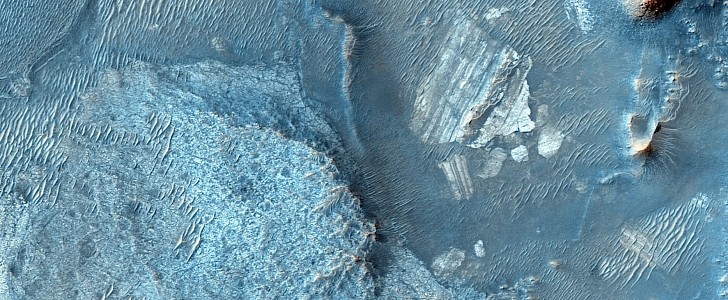Whenever it decides on a mission to Mars, NASA goes through a series of procedures to ensure the chosen landing site for whatever hardware it's sending there is the best possible one. That means several locations are selected at first, and then eliminated along the way, as scientists go through their checklists and hope for the best.
The Curiosity rover, for instance, departed Earth in 2011, and set itself down on the surface of the Red Planet one year later. It landed in the Gale crater, which could have once been a lake and was considered at the time to have a good probability of hosting signs of life.
Gale was the winner in a race that also included, in its final form, the Eberswalde crater, Holden crater, and Mawrth Vallis. Earlier on, when the list was even larger, a place called Nili Fossae was also being looked at intently.
The region made it onto the list because it “has one of the largest, most diverse exposures of clay minerals” that we know of. These minerals hold water, and by extension a great chance of being home to some sort of organic material.
The main photo of this piece shows a small portion of Nili Fossae, as seen through the lens of the HiRISE orbital camera back in 2014, from an altitude of 279 km (173 miles). Recently published by the University of Arizona, it shows another feature that could have made the place a suitable landing place - in fact, it kind of looks like a landing pad.
We’re talking about a “large angular fragment that appears to have light and dark-toned bands.” As usual with most areas revealed by HiRISE images, scientists cannot really explain what the banding is, but study of these images is ongoing.
We’re pretty sure though someone somewhere wishes the Curiosity rover would have landed here instead of Gale.
Gale was the winner in a race that also included, in its final form, the Eberswalde crater, Holden crater, and Mawrth Vallis. Earlier on, when the list was even larger, a place called Nili Fossae was also being looked at intently.
The region made it onto the list because it “has one of the largest, most diverse exposures of clay minerals” that we know of. These minerals hold water, and by extension a great chance of being home to some sort of organic material.
The main photo of this piece shows a small portion of Nili Fossae, as seen through the lens of the HiRISE orbital camera back in 2014, from an altitude of 279 km (173 miles). Recently published by the University of Arizona, it shows another feature that could have made the place a suitable landing place - in fact, it kind of looks like a landing pad.
We’re talking about a “large angular fragment that appears to have light and dark-toned bands.” As usual with most areas revealed by HiRISE images, scientists cannot really explain what the banding is, but study of these images is ongoing.
We’re pretty sure though someone somewhere wishes the Curiosity rover would have landed here instead of Gale.






